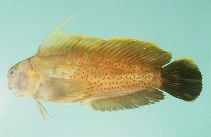| Family: |
Blenniidae (Combtooth blennies), subfamily: Salariinae |
| Max. size: |
9.4 cm SL (male/unsexed) |
| Environment: |
reef-associated; marine; depth range 0 - 16 m |
| Distribution: |
Western Pacific: off eastern Australia from Lady Musgrave Reef northward to Sir Charles Hardy Islands, as far north as Basilaki Islands, Papua New Guinea; as far south as Lord Howe Island; and eastward to Fiji and Tonga Islands. |
| Diagnosis: |
Dorsal spines (total): 12-13; Dorsal soft rays (total): 14-16; Anal spines: 2-2; Anal soft rays: 15-17; Vertebrae: 29-30. Diagnosis: Dorsal fin XII-XIII, 14-16 (usually XII, 15), attached to caudal fin, with shallow notch above last spine, first spine equal or about twice higher than second, higher in males; anal fin II, 15-17 (usually 15); pectoral rays 15; pelvic fin I, 4; caudal fin procurrent rays 10-14. Vertebrae 9-11 (usually 10) + 19-20; last pleural rib on 11th vertebral centrum, last epipleural rib on 15-18th. Body depth at anal-fin origin 3.3-3.5 in SL. LL, without scales and scalelike flaps; LL tubes 0-8 (usually 1-5), incomplete, series ends below 12th dorsal spine to 10th dorsal ray. Lower lip smooth mesially, plicate laterally. Upper lip crenulae 29-43. Gill rakers 20-28. Cephalic sensory pore system simple. Cirri: supraorbital 3-12 (rarely up to 23 or 93; usually 6-9); nasal 6-25 (rarely up to 82; usually less than 15); nuchal 22-45 (usually 27-32), in 4 groups with slightly expanded nuchal flap at bases of ventralmost cirri. Over all brown with red small spots; iris red; pectoral fins yellow; rugosities of anal spine dirty yellow (Ref. 529, 90102). |
| Biology: |
Adults inhabit shallow rocky and coral reefs (Ref. 9710) commonly below 10 m (Ref. 90102). Oviparous. Eggs are demersal and adhesive (Ref. 205), and are attached to the substrate via a filamentous, adhesive pad or pedestal (Ref. 94114). Larvae are planktonic, often found in shallow, coastal waters (Ref. 94114). Common depth minimum of 7 m reported from Ref. 9710 but that is maximum common depth in Ref. 529. |
| IUCN Red List Status: |
Least Concern (LC); Date assessed: 24 March 2009 Ref. (130435)
|
| Threat to humans: |
harmless |
Source and more info: www.fishbase.org. For personal, classroom, and other internal use only. Not for publication.

